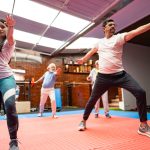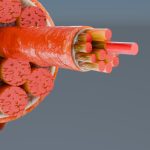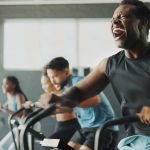
Osteoporosis is a bone disease characterized by micro-architectural deterioration of bone tissue and loss of bone mass. It affects 13.4 million people aged 50 and over (11.2 million women and 2.2 million men) (CDC). Low bone density, the precursor to osteoporosis, affects 47.6 million people with low bone mass (30.7 million women and 16.9 million men). The biggest concern with osteoporosis is bone tissue loss, which increases bone fragility and susceptibility to fracture. Due to the prevalence of bone disease, up to 1.5 million fragility fractures, or fractures that don’t occur at healthy bone levels, occur each year in America.
Aging, hormonal changes (significantly decreased estrogen in women after menopause), low calcium and vitamin D intake, certain medications, and lifestyle choices contribute to osteoporosis (Clynes). In this article, we’ll examine evidence-based research on osteoporosis so that personal trainers can better prepare to work with clients with the condition. The following topics will be examined regarding exercise as a lifestyle intervention approach:
- Effect of exercise
- Exercise response
- Exercise recommendations
- Exercise contraindications
Osteoporosis Pathology
Osteoporosis fits into either primary or secondary osteoporosis (Adej). Primary osteoporosis includes conditions without an underlying cause, such as idiopathic and involutional osteoporosis (Adej). Idiopathic osteoporosis occurs in children and young adults and has no known cause. Involutional osteoporosis affects both men and women and is closely related to aging and hormonal imbalances (Adej).
Involutional osteoporosis can be classified into Type I and Type II (Adej). Type I affects postmenopausal women and is referred to as “postmenopausal osteoporosis” (Adej). Type II, referred to as “senile osteoporosis,” mainly affects those over 75 years of age (Adej). Secondary osteoporosis occurs due to an underlying disease or medication use and accounts for less than 5% of all cases of osteoporosis (Adej).
At the cellular level, osteoporosis results from osteoclastic bone resorption not compensated by osteoblastic bone formation. The four primary cells in the bone are osteoclasts, osteoblasts, and osteocytes. Osteoclasts are responsible for bone resorption, while osteoblasts are responsible for bone formation. Osteocytes provide nutrition to the bone cells and regulate osteoclast and osteoblast activity (Nahian). Osteoprogenitor cells are stem cells that can develop into osteoblasts.
As the condition progresses, a loss in bone architecture can be observed, where the bone becomes thinner and more porous.
Effects of Exercise
Exercise throughout the life stages both maintains and builds bone tissue. Bones loaded through exercise see an increase in mineral density and content. Bone density is measured at the femoral neck and lumbar spine. Nevertheless, various exercises can influence bone density differently, and the effectiveness of these exercises on bone density remains inconsistent across studies.
It is clear that exercise drastically improves osteoporosis outcomes compared to no exercise (Ott). Many forms of exercise can increase bone density in the femoral neck, whereas some specific exercises may be needed for the lumbar spine to improve significantly (Zhang).
How Does Exercise Build Bone Density?
Apoptosis Reduction and Stem Cell Production
Exercise may influence apoptosis and autophagy by triggering the release of exercise-induced myohormones and facilitating the secretion of anti-inflammatory cytokines through mechanical force (Zhang L). Additionally, it could affect the epigenetic processes related to bone metabolism.
Mechanical stimulation encourages the differentiation of bone marrow mesenchymal stem cells (BMSCs) into osteogenic cells by modifying the expression of non-coding RNAs (Zhang L). Moreover, mechanical stimuli can reduce DNA methylation, which may alter the epigenetic status of osteogenic genes, leading to increased expression.
Reducing Inflammation
Regular exercise helps to prevent and mitigate osteoporosis by lowering pro-inflammatory cytokines and curbing inflammation. It promotes the release of anti-inflammatory cytokines such as IL-2, IL-10, IL-12, and interferon (IFN), which support bone formation, while also reducing the levels of pro-inflammatory cytokines like IL-1, IL-6, and TNF-α to safeguard bone health resorption (Lin Zhang).
Regulating Autophagy
Exercise influences bone metabolism by enhancing autophagy in bone tissue cells (Lin Zhang). Autophagy refers to the body’s recycling of old or damaged cell components. As a cellular recycling system, autophagy enables cells to dismantle and repurpose these waste components into new, functional parts. This process allows cells to eliminate unnecessary pieces.
Increased Blood Flow, Fluid, and Vascularity
Bone is a highly vascularized tissue with a vast network of blood vessels and capillaries that provide oxygen and nutrients for bone formation and development (Tong). Exercise also increases bone marrow and blood flow during exercise, supplying crucial nutrients, oxygen, growth factors, and hormones vital for bone health cells.
Moreover, mechanical loading creates compressive forces in various bone regions, facilitating interstitial fluid flow from high-pressure to low-pressure areas. This mechanism encourages osteoblastic osteogenesis and inhibits osteoclast formation (Tong).
Exercise Recommendations
The National Osteoporosis Foundation (NOF) recommends high- and low-impact weight-bearing and muscle-strengthening exercises to help prevent osteoporosis (Papadopoulou). High-impact options include jumping, jogging, and aerobics, while lower-impact alternatives consist of walking and step aerobics.
Muscle-strengthening exercises involve weight lifting, using elastic exercise bands, and performing activities that provide resistance against gravity. Although walking offers advantages for body composition and cardiometabolic health, its impact on osteoporosis prevention is minimal or nonexistent (Papadopoulou).
As mentioned before, studies vary on the effectiveness of different exercise modalities on improving bone density. Until more research can conclude specific exercise recommendations, a combined exercise approach of resistance training moderate-impact weight-bearing exercises should be implemented. Note the more severe the osteoporosis, the less intense the exercise should be, as the bones are more susceptible to fracture.
Low-Risk Individuals
“Low risk” means free from osteoporosis symptoms, having a ‘normal’ BMD (T-score above -1.0 SD), maintaining suitable functional status, and lacking clinical risk factors for falls or fractures (such as in children, adolescents, and healthy adults). A bone-targeted exercise program for these low-risk individuals aims to enhance bone and muscle mass and strength (Beck).
- High impact Jumps and/or hops
- Multidirectional weight-bearing exercises
- Recreational sporting activities
- Progressive resistance training
Moderate-Risk Individuals
“Moderate risk” means low bone mass (T-score −1.0 to −2.5 SD) and/or certain clinical or functional risk factors for fracture. For moderate-risk individuals, an exercise program aims to preserve or improve bone mass and strength and muscle strength, power, and balance (Beck).
- Moderate-impact activities like running, jumping rope, and sports
- Moderate advancing to high-intensity progressive resistance training
- More balance activities than low-risk individuals to reduce fall risk
High-Risk Individuals
“High risk” means having osteoporosis (T-score less than −2.5 SD), previous fracture, and/or multiple risk factors for fracture. The absolute magnitude of load that can be applied to an osteoporotic skeleton without incurring a fracture is unknown (Beck).
- Light advancing to moderate progressive resistance training
- Light to moderate weight-bearing activities
- Avoid high-impact or high-balance exercises until progress to gradually
List of Helpful Exercises to Modify to the Respective Stage of Osteoporosis (Beck)
- Bounding, hopping, skipping, jumping, drop jumps
- Step ups and downs, lunges, squats, deadlifts, hip hinges, etc, progressing to resistance exercises
- Dorsi and plantar flexion exercises
- Upper body push and pull resistance exercises
- Standing and moving exercises for balance with varying levels of support and perturbations
- Different gait patterns such as tandem walking, backward, sideways, circles, pivot turns, etc
Exercises Programming Variables (training guidelines)
Aerobic and resistance training guidelines from the American Council on Exercise, the American College of Sports Medicine, and the National Strength and Conditioning Association can all be followed. They all recommend similar guidelines, such as 150 minutes of light to moderate cardio weekly and 2-3 resistance training sessions a week.
Exercise Modality Order
Exercises should be introduced based on the specific impairments present. For instance, standing and walking across a room requires muscle strength, balance, and endurance in that order (Beck). Consequently, the most reasonable exercise progression for an individual who is frail and has transfer and mobility challenges begins with progressive resistance training, followed by balance exercises, and concludes with weight-bearing activities.
Whole Body Vibration
Vibration therapy is a fascinating modality for treating osteoporosis because vibration can transmit force through the bones. However, it only improves bone density in the femoral neck, not the lumbar spine or total hip (Zhang). Its effectiveness could be attributed to participants doing weight-bearing activities on the device, making it difficult to determine whether the device or exercise improved bone density.
It could be a viable option for frail individuals with severe osteoporosis. However, there is no consensus on the best parameters for whole-body vibration, and access to the device may be impractical.
Combined Exercise
The meta-analysis included fourteen randomized controlled trials involving postmenopausal women: 544 participants in the experimental group and 495 in the control group (Linhares). The average age of participants was 68.4 years. These studies incorporated two to four exercise types: strength, aerobic, balance, flexibility, and/or functional fitness training.
Engaging in multicomponent training, averaging 27.2 weeks with 2.6 sessions a week lasting 45 minutes each, improved strength, flexibility, quality of life, bone mineral density, balance, and functional fitness, alongside a decreased risk of falls among older women with osteoporosis. Overall, the combined exercise effectively enhanced health-related variables for this demographic, including bone density.
Exercise Contraindications
Those with vertebral osteoporosis or kyphosis should refrain from deep forward flexion movements, particularly when lifting or carrying objects (e.g., rowing, lifting weights with a bent spine, yoga, Pilates, bowling, sit-ups, and working in the yard or home) to avoid vertebral wedge fractures (Beck).
Likewise, high-impact activities and exercises involving quick and/or weighted twisting, as well as sudden or explosive movements (such as golf and racquet sports), may pose risks for individuals highly susceptible to low trauma fractures, especially those with vertebral osteoporosis, poor balance, or osteoarthritis (Beck). High-risk individuals must be trained in safe lifting and proper posture techniques to prevent dangerous or excessive loading while engaging in daily tasks or recreational activities.
To Mitigate Fractures from Falls or Exercises
- Implement balance training, especially near the beginning of the workout as not to struggle with balance due to fatigue
- Ensure proper lighting, footwear, and clear exercise space
- Avoid fast and loaded rotation movements of the spine
- Avoid loaded spine flexion in kyphotic clients
- Use balance aids or stable objects to hold onto while exercising
Conclusion
Osteoporosis is a significant health concern, particularly among older adults, due to its effects on bone fragility and fracture risk. Fortunately, evidence-based research highlights exercise as a powerful lifestyle intervention to enhance bone density, improve muscle strength, and reduce fall risk (Daly, Anupama). While different forms of exercise produce varying results, a well-structured program that includes resistance training, weight-bearing activities, and balance exercises can help individuals at all risk levels maintain or improve bone health (Bae).
However, exercise selection must be tailored to the severity of osteoporosis to ensure safety and effectiveness. By understanding the pathology of osteoporosis and implementing appropriate exercise strategies, personal trainers can play a crucial role in helping clients manage and mitigate the effects of this condition condition.
Sources
- Clynes MA, Harvey NC, Curtis EM, Fuggle NR, Dennison EM, Cooper C. The epidemiology of osteoporosis. Br Med Bull. 2020 May 15;133(1):105-117. doi: 10.1093/bmb/ldaa005. PMID: 32282039; PMCID: PMC7115830.
- Nahian A, AlEssa AM. Histology, Osteocytes. [Updated 2023 May 1]. In: StatPearls [Internet]. Treasure Island (FL): StatPearls Publishing; 2025 Jan-. Available from: https://www.ncbi.nlm.nih.gov/books/NBK558990/
- Adejuyigbe B, Kallini J, Chiou D, Kallini JR. Osteoporosis: Molecular Pathology, Diagnostics, and Therapeutics. Int J Mol Sci. 2023 Sep 26;24(19):14583. doi: 10.3390/ijms241914583. PMID: 37834025; PMCID: PMC10572718.
- Papadopoulou SK, Papadimitriou K, Voulgaridou G, Georgaki E, Tsotidou E, Zantidou O, Papandreou D. Exercise and Nutrition Impact on Osteoporosis and Sarcopenia-The Incidence of Osteosarcopenia: A Narrative Review. Nutrients. 2021 Dec 16;13(12):4499. doi: 10.3390/nu13124499. PMID: 34960050; PMCID: PMC8705961.
- Zhang S, Huang X, Zhao X, Li B, Cai Y, Liang X, Wan Q. Effect of exercise on bone mineral density among patients with osteoporosis and osteopenia: A systematic review and network meta-analysis. J Clin Nurs. 2022 Aug;31(15-16):2100-2111. doi: 10.1111/jocn.16101. Epub 2021 Nov 1. PMID: 34725872.
- Linhares DG, Borba-Pinheiro CJ, Castro JBP, Santos AOBD, Santos LLD, Cordeiro LS, Drigo AJ, Nunes RAM, Vale RGS. Effects of Multicomponent Exercise Training on the Health of Older Women with Osteoporosis: A Systematic Review and Meta-Analysis. Int J Environ Res Public Health. 2022 Oct 30;19(21):14195. doi: 10.3390/ijerph192114195. PMID: 36361073; PMCID: PMC9655411.
- Zhang L, Zheng YL, Wang R, Wang XQ, Zhang H. Exercise for osteoporosis: A literature review of pathology and mechanism. Front Immunol. 2022 Sep 9;13:1005665. doi: 10.3389/fimmu.2022.1005665. PMID: 36164342; PMCID: PMC9509020.
- Tong X, Chen X, Zhang S, Huang M, Shen X, Xu J, Zou J. The Effect of Exercise on the Prevention of Osteoporosis and Bone Angiogenesis. Biomed Res Int. 2019 Apr 18;2019:8171897. doi: 10.1155/2019/8171897. PMID: 31139653; PMCID: PMC6500645.
- Beck BR, Daly RM, Singh MA, Taaffe DR. Exercise and Sports Science Australia (ESSA) position statement on exercise prescription for the prevention and management of osteoporosis. J Sci Med Sport. 2017 May;20(5):438-445. doi: 10.1016/j.jsams.2016.10.001. Epub 2016 Oct 31. PMID: 27840033.
- Ott SM. In osteoporosis or osteopenia, exercise interventions improve BMD; effects vary by exercise type and BMD site. Ann Intern Med. 2022 Apr;175(4):JC46. doi: 10.7326/J22-0014. Epub 2022 Apr 5. PMID: 35377720.
- Daly RM, Dalla Via J, Duckham RL, Fraser SF, Helge EW. Exercise for the prevention of osteoporosis in postmenopausal women: an evidence-based guide to the optimal prescription. Braz J Phys Ther. 2019 Mar-Apr;23(2):170-180. doi: 10.1016/j.bjpt.2018.11.011. Epub 2018 Nov 22. PMID: 30503353; PMCID: PMC6429007.
- Anupama DS, Norohna JA, Acharya KK, Ravishankar, George A. Effect of exercise on bone mineral density and quality of life among postmenopausal women with osteoporosis without fracture: A systematic review. Int J Orthop Trauma Nurs. 2020 Nov;39:100796. doi: 10.1016/j.ijotn.2020.100796. Epub 2020 Jul 28. PMID: 33041224.
- Bae S, Lee S, Park H, Ju Y, Min SK, Cho J, Kim H, Ha YC, Rhee Y, Kim YP, Kim C. Position Statement: Exercise Guidelines for Osteoporosis Management and Fall Prevention in Osteoporosis Patients. J Bone Metab. 2023 May;30(2):149-165. doi: 10.11005/jbm.2023.30.2.149. Epub 2023 May 31. PMID: 37449348; PMCID: PMC10345999.






